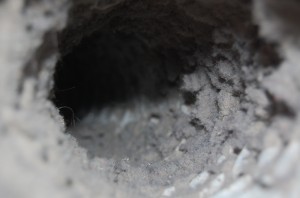 Can a dryer exhaust hose really be costing you money? This is a picture of a dryer hose that cost the homeowner not only money but a considerable amount of time as well. The current code allows the use of flexible type of dryer hose like that in the picture. Code also allows this type of exhaust line to be installed un-insulated as it runs through unconditioned spaces like your crawl space or, in the case of this piece of dryer hose, through the un-insulated ceiling of a porch.
Can a dryer exhaust hose really be costing you money? This is a picture of a dryer hose that cost the homeowner not only money but a considerable amount of time as well. The current code allows the use of flexible type of dryer hose like that in the picture. Code also allows this type of exhaust line to be installed un-insulated as it runs through unconditioned spaces like your crawl space or, in the case of this piece of dryer hose, through the un-insulated ceiling of a porch.
So imagine, if you will, what happens when you have very warm, very moist (relative humidity at around 90%) air running through a piece of pipe made out of metallic material through an un-insulated space. Now imagine that the outdoor temperature is considerably cooler than the temperature in the pipe. Can you guess what will be occurring? If you guessed condensation, give yourself a greenie point (they’re much better than brownie points).
The moist air condensates on the inside of the metallic ductwork rendering it into the perfect sticky location for any lint that might be flying by to begin to accumulate. This happens more frequently than you might think, especially in flex duct that has many twists and bends. This precise situation is why the new Energy Star 3.0 requirements insist that all ventilation ductwork running through unconditioned spaces be insulated with a minimum of R-8 insulation. Hurray for Energy Star.
Why would this cause you grief or cost you time and money? Because moist dryer vents accumulate vast amounts of lint rather quickly. Do you detach your dryer hoses and clean them out? I didn’t think so, most people don’t. Then after the lint accumulates, it not only becomes a fire hazard but it also can create back pressure within the dryer itself. This particular hose created enough back pressure within the hose to cause a temperature safety switch to overheat and fail. This rendered the heating portion of the dryer useless. The dryer ran on and on for hours tumbling wet clothes without ever turning the heat on and without ever drying the clothes.
All of this could have been avoided with a little bit of duct insulation and a proper install. Building green is building smart. It pays to use your head. Check your dryer hose today, or call us to do an audit we have found many things such as this during our audits. And if you find that it is full of lint, vacuum it out and fix it. I would love to see the pictures of your dryer hose when you disconnect it. Send me a picture at e.guinn@DanGuinnHomes.com or post it to our Facebook page at Dan Guinn Homes. Thanks for reading.
